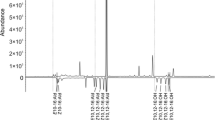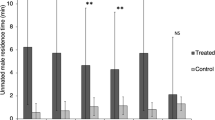Abstract
Selected combinations of (Z)-5-decenyl, (Z)-7-dodecenyl, and (Z)-9-tetradecenyl acetates, the pheromone components of the turnip mothAgrotis Segetum were tested for field attractancy at six, two, and three sites in Europe, Asia, and Africa, respectively. At all of the sites in Eurasia and in northern Africa the ternary mixture of the acetates captured most males, while at the sites south of the Sahara in Africa, (Z)-5-decenyl acetate alone was responsible for attraction. Differences in male attraction among the populations studied confirm the existence of significant population variation in the pheromone ofA. segetum. Interpretation of the present results together with earlier studies suggests that this variation is more or less continuous in Eurasia and north Africa, while a clearly distinct pheromone type is present in the areas south of the Sahara desert.
Similar content being viewed by others
References
Anderbrant, O., Löfquist, J., Jönsson, J., andMarling, E. 1989. Effects of pheromone trap type, position and colour on the catch of the pine sawflyNeodiprion sertifer (Geoff.) (Hym., Diprionidae).J. Appl. Entomol. 107:365–369.
Arn, H., Rauscher, S., andSchmid, A. 1979. Sex attractant formulations and traps for the grape mothEupoecilia ambiguella Hb.Mitt. Schweiz. Entomol. Ges. 52:49–55.
Arn, H., Städler, E., Rauscher, S., Buser, H.R., Mustaparta, H., Esbjerg, P., Philipsen, H., Zether, O., Struble, D.L., andBues, R. 1980. Multicomponent sex pheromone inAgrotis segetum: Preliminary analysis and field evaluation.Z. Naturforsch. 35C:986–989.
Arn, H., Esbjerg, P., Bues, R., Tòth, M., Szöcs, G., Guerin, P., andRauscher, S. 1983. Field attraction ofAgrotis segetum males in four European countries to mixtures containing three homologous acetates.J. Chern. Ecol. 9:267–276.
Arn, H., Tòth, M., andPriesner, E. 1986. List of sex pheromones of Lepidoptera and related attractants. OILB-SROP Publ., Paris, 123 pp.
Bestmann, H.J., Vostrowsky, O., Koschatzky, K.H., Platz, H., Brosche, T., Kantardijew, I., Rheinwald, M., andKnauf, W. 1978. (Z)-5-Decenylacetat, ein Sexuallockstoff für Männchen der SaateuleAgrotis segetum (Lepidoptera).Angew. Chem. 10:815–816.
Cayrol, R.A. 1966. Famille des Noctuidae, pp. 1255–1470,in A.S. Balachowsky (ed.). Entomologie appliquée à l'agriculture, Vol. 2. Masson et Cie, Paris.
Dunkelblum, E., andGothilf, S. 1984. Sex attractant blends for field trapping ofAgrotis segetum males (Lepidoptera: Noctuidae) in Israel and Germany.Z. Naturforsch. 40C:272–277.
Hansson, B.S., Tòth, M., Löfstedt, C., Szöcs, G., Subchev, M., andLöfquist, J. 1990. Pheromone variation among Eastern European and a Western Asian population of the turnip mothAgrotis segetum.J. Chem. Ecol. 16:1611–1622.
Löfstedt, C. 1990. Population variation in moth pheromone communication systems and its genetic control.Entomol. Exp. Appl. 54:199–218.
Löfstedt, C., Van Der Pers, J.N.C., Löfquist, J., Lanne, B.S., Appelgren, M., Bergström, G., andThelin, B. 1982. Sex pheromone components of the turnip moth,Agrotis segetum: Chemical identification, electrophysiological evaluation and behavioural activity.J. Chem. Ecol. 10:1305–1321.
Löfstedt, C., Lanne, B.S., Löfquist, J., andBergström, G. 1985. Individual variation in the pheromone of the turnip mothAgrotis segetum.J. Chem. Ecol. 11:1181–1196.
Löfstedt, C., Löfquist, J., Lanne, B.S., Van Der Pers, J.N.C., andHansson, B.S. 1986. Pheromone dialects in European turnip mothsAgrotis segetum.Oikos 46:250–257.
Steck, W.F., Underhill, E.W., Chisholm, M.D., andByers, J.R. 1979. Sex attractants forAgrotis venerabilis andEuxoa albipennis based on (Z)-5-decenyl acetate and (Z)-7-dodecenyl acetate.Environ. Entomol. 8:1126–1128.
Subchev, M.A., Krusteva, I.A., andArn, H. 1986. Bulgarian pheromone “dialect” ofAgrotis segetum Den. & Schiff. (Lepidoptera: Noctuidae).Ekologiya 19:71–75.
Sugi, S. 1958. Noctuidae, pp. 431–619,in H. Inoue, (ed.). Checklist of the Lepidoptera of Japan. Part 5. Rikushiusha 112/4, Itiarai, Otaku, Tokyo, Japan.
Sugi, S. 1982. Moths of Japan. Noctuidae, pp. 1–552,in H. Inoue, (ed.). Moths of Japan. I-II. Kodansha, Tokyo.
Szöcs, G., Töth, M., andNovàk, L. 1983. Sex attractants and inhibitors for lepidopterous species found by field screening of olefinic compounds in Hungary.Z. Angew. Entomol. 96:56–67.
Takahashi, S., Sato, Y., andKodama, T. 1983. Attractiveness of synthetic sex pheromone to males of the lorey leafworm,Acantholeucania loreyi (Duponchel).Appl. Entomol. Zool. 18:435–437.
Tòth, M., Jakab, J., andNovàk, L. 1980. Identification of two components from the sex pheromone system of the white-line dart moth,Scotia segetum (Schiff.) (Lep., Noctuidae).Z. Angew. Entomol. 90:505–510.
Tòth, M., Szocs, G., Majoros, B., Bellas, T.E., andNovàk, L. 1983. Experiments with a 2-component sex attractant of the silver Y moth (Autographa gamma L.), and some evidence for the presence of both components in natural female sex pheromone.J. Chem. Ecol. 9:1317–1325.
Wakamura, S. 1978. Sex attractant pheromone of the common cutworm moth,Agrotis fucosa Butler (Lepidoptera: Noctuidae): Isolation and identification.Appl. Entonol. Zool. 13:290–295.
Wakamura, S. 1980. Sex attractant pheromone of the common cutworm mothAgrotis fucosa Butler: field evaluation.Appl. Entomol. Zool. 15:167–174.
Wakamura, S., Kegasawa, K., Endo, T., Matsuura, H., Koshihara, H., Tomioka, T., Nemoto, H., andKitakuchi, Y. 1981. Sex attractant pheromone of the turnip moth,Agrotis segetum Denis et Schiffermüller (Lepidoptera: Noctuidae): Seasonal prevalence obtained by synthetic sex pheromone traps.Jpn. J. Appl. Entomol. Zool. 25:265–271.
Wilkinson, L. 1989. SYSTAT: The system for statistics. Systat Inc., Evanston, Illinois.
Author information
Authors and Affiliations
Rights and permissions
About this article
Cite this article
Tòth, M., Löfstedt, C., Blair, B.W. et al. Attraction of male turnip mothsAgrotis segetum (Lepidoptera: Noctuidae) to sex pheromone components and their mixtures at 11 sites in Europe, Asia, and Africa. J Chem Ecol 18, 1337–1347 (1992). https://doi.org/10.1007/BF00994360
Received:
Accepted:
Issue Date:
DOI: https://doi.org/10.1007/BF00994360




